How Localities and States Can Prepare for Broadband Expansion

A Consolidated Communications technician works on a line used to provide broadband internet service in a rural area on Wednesday, July 29, 2020, in Stowe, Vt. Vermont officials are working to expand internet service using federal pandemic relief funds. AP Photo/Wilson Ring
Governments can use American Rescue Plan Act funding to pay for broadband infrastructure. Experts say local governments are in the best position to know what initiatives will work to connect residents.
The pandemic made gaps in internet connectivity starkly apparent across the country.
As federal relief funding begins to flow, broadband experts and local leaders say governments can play a key role in devising plans to connect residents.
The $1.9 trillion American Rescue Plan Act allocates $350 billion in direct aid to states and local governments, which can be spent on a wide range of needs, including broadband infrastructure. It also dedicates another $10 billion to states through the Capital Projects Fund that can be used on broadband connectivity infrastructure.
Because barriers to broadband access vary widely from neighborhood to neighborhood and household to household, local governments are best positioned to figure out what assistance residents need in order to log on, experts said.
Rural communities may lack the basic infrastructure to offer high-speed internet service. While in densely populated cities, the infrastructure may exist, but residents can’t afford high-speed internet or don’t have devices that can connect.
“Each community has their own challenges they are grappling with,” said Ryan Johnston, the policy counsel for federal programs at Next Century Cities.
There’s no silver bullet solution to connect all residents across the board, said Kathryn de Wit, project director of the broadband access initiative at The Pew Charitable Trusts.
“The most effective approaches are tailored to each community’s specific needs and supported by strong planning and collaboration to ensure every household and business has affordable broadband access,” she said.
States and local governments are just beginning to receive ARPA money and some governments have announced plans to use some of their funding on broadband expansion. Wisconsin Gov. Tony Egers, for example, said he would direct $100 million of the state's federal funds to broadband access.
Virginia has doubled down on its commitment to broadband infrastructure.
Gov. Ralph Northam announced Friday the state will commit $700 million in ARPA funding toward an initiative that will fund last-mile infrastructure in unserved areas. The funding is expected to bump up the governor’s goal of establishing universal internet access across the state from 2028 to 2024. establishment of universal internet access across the state
At the state level, broadband continued to be a funding priority throughout the coronavirus pandemic. Twelve state legislatures approved funding for existing broadband initiatives last year and six states—Arkansas, Kansas, Kentucky, Michigan, Oregon, and Pennsylvania—passed legislation to create new broadband funds, according to Pew.
However, it’s unclear how many municipalities will use the money for connectivity initiatives as many remain focused on stabilizing measures to address lost revenue or workforce issues, said Angelina Panettieri, a legislative director at the National League of Cities.
Direct aid to local governments is being distributed evenly in two tranches, with the first payments out this year and the second half delivered next year. If cities use the first round to “stop the bleeding,” it may not be until next year that they start to use funding on infrastructure initiatives like broadband, Panettieri said.
During the pandemic, many cities, towns and counties focused on getting laptops and tablets to students and libraries in order to keep children learning and close the homework gap. Besides the ARPA money, other new federal programs are providing subsidies to help students and families afford internet service or connected devices.
Preparing for Broadband Expansion
For cities interested in using the federal dollars on broadband, Panettieri said it’s important they first have a good grasp of the barriers in their communities and let that steer the solutions.
An assessment of connectivity gaps and connection speeds in the community could be useful, she said. A digital equity assessment could also help identify the reasons why residents aren’t connected even when they live in areas where broadband is physically available.
In addition, local governments can work with internet service providers to reduce locally imposed barriers such as right of way or engineering fees or to cut the timeline for project review and approval, recommends the National Association of Counties in a recent report.
Smaller localities may not have the manpower or expertise to carry out these types of assessments, so they may find it helpful to coordinate with their state’s broadband office, Johnston said. A recent Pew report on state-level broadband programs noted that by offering planning and technical assistance to local entities, state programs can help build capacity and provide the resources localities need to successfully implement broadband initiatives.
When planning for broadband expansion, localities should consider things like defining a minimum standard for broadband speeds and implementing dig once policies, NACO recommends.
Most states have broadband offices, so outreach and coordination with the state could be a good first step for smaller cities that do not have a broadband deployment plan, Johnston said. With money going to both municipalities and states, collaboration can help maximize funding.
In West Virginia, for example, the Department of Economic Development and the state’s Broadband Enhancement Council started a Broadband Investment Program, which will serve as a way to coordinate ARPA funding on state and local levels.
“To the extent localities are able to coordinate with one another on projects but also with states on economies of scale to tap multiple funding streams, that is going to be really helpful,” Panettieri said.
Andrea Noble is a staff correspondent with Route Fifty.
NEXT STORY: State Data Privacy Bills Growing More Widespread





